HAT203 Tourism: Strategic Alliance in Airline Industry Case Study
VerifiedAdded on 2023/03/23
|11
|1820
|24
Case Study
AI Summary
This case study provides an analysis of strategic alliances within the airline industry, examining both the macro and micro contexts that drive their formation. The macro context explores the impact of the information revolution, economic restructuring, and global competition. The micro context delves into risk sharing, economies of scale, scope, and learning, access to resources, and shaping competition. A SWOT analysis further elucidates the strengths, weaknesses, opportunities, and threats associated with these alliances, highlighting both the potential benefits and challenges for participating airlines. The study concludes that strategic alliances have been a game changer, especially in the context of risk hedging. Desklib offers a wealth of similar case studies and solved assignments for students seeking to deepen their understanding of business strategy.
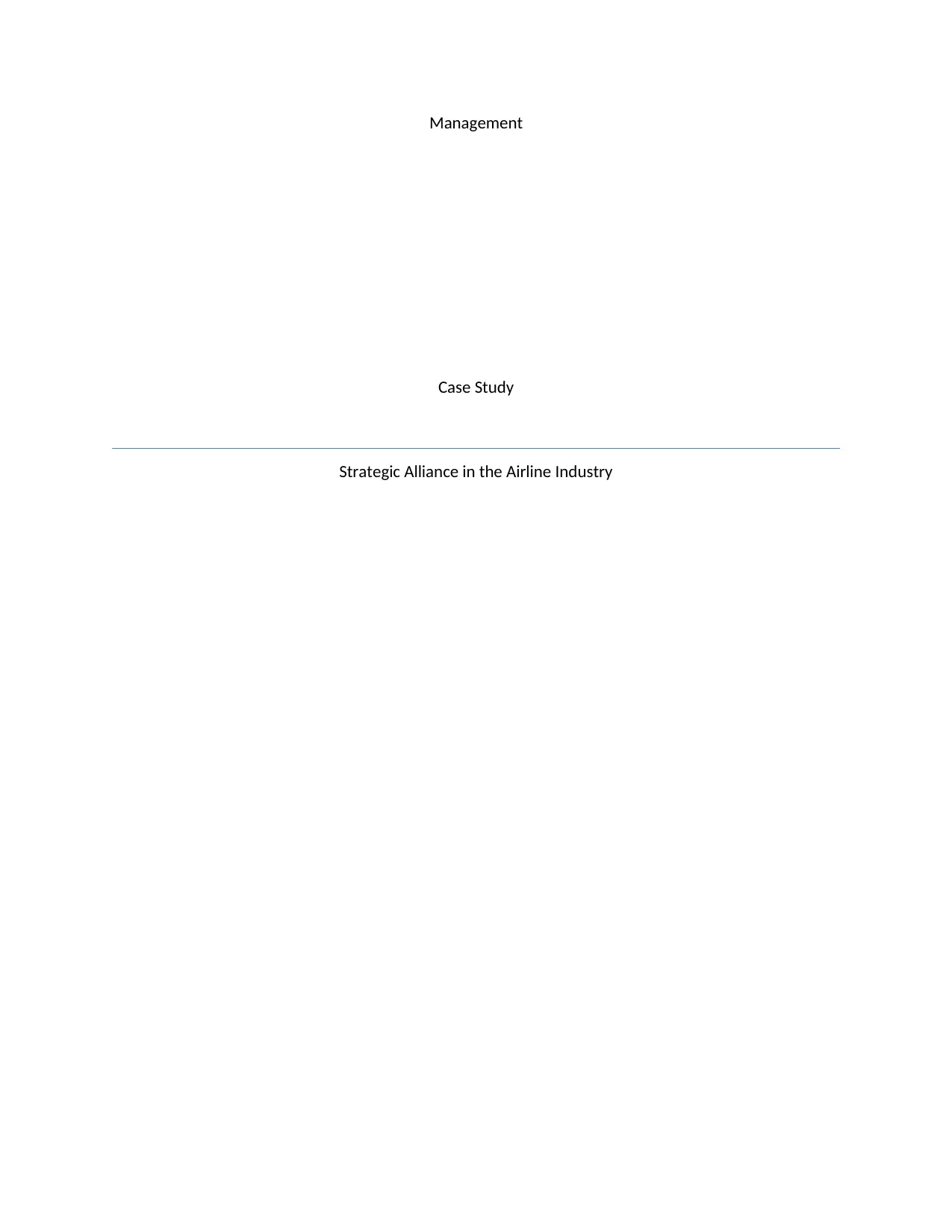
Management
Case Study
Strategic Alliance in the Airline Industry
Case Study
Strategic Alliance in the Airline Industry
Paraphrase This Document
Need a fresh take? Get an instant paraphrase of this document with our AI Paraphraser
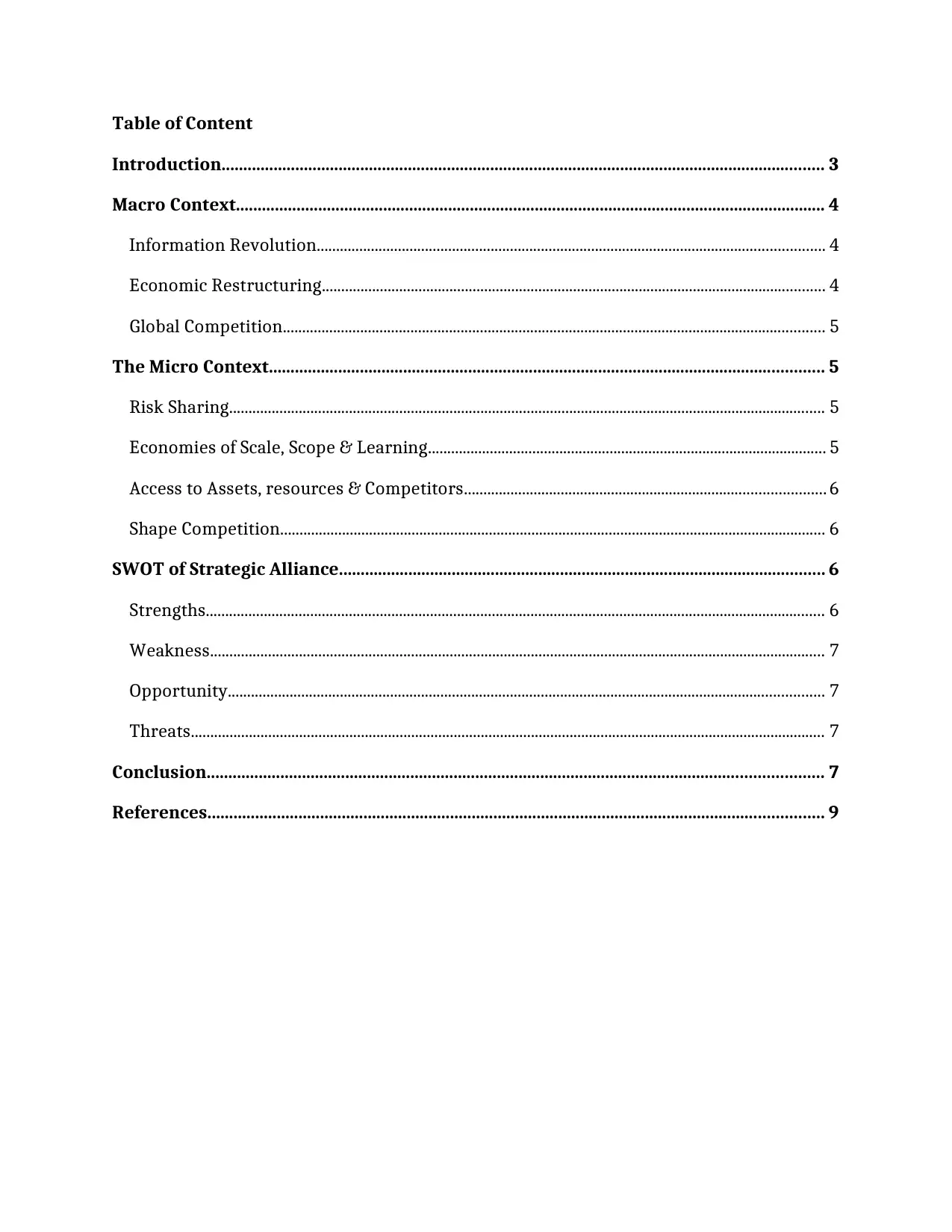
Table of Content
Introduction........................................................................................................................................... 3
Macro Context........................................................................................................................................ 4
Information Revolution................................................................................................................................... 4
Economic Restructuring.................................................................................................................................. 4
Global Competition............................................................................................................................................ 5
The Micro Context................................................................................................................................ 5
Risk Sharing.......................................................................................................................................................... 5
Economies of Scale, Scope & Learning....................................................................................................... 5
Access to Assets, resources & Competitors............................................................................................. 6
Shape Competition............................................................................................................................................. 6
SWOT of Strategic Alliance................................................................................................................ 6
Strengths................................................................................................................................................................ 6
Weakness............................................................................................................................................................... 7
Opportunity.......................................................................................................................................................... 7
Threats.................................................................................................................................................................... 7
Conclusion.............................................................................................................................................. 7
References.............................................................................................................................................. 9
Introduction........................................................................................................................................... 3
Macro Context........................................................................................................................................ 4
Information Revolution................................................................................................................................... 4
Economic Restructuring.................................................................................................................................. 4
Global Competition............................................................................................................................................ 5
The Micro Context................................................................................................................................ 5
Risk Sharing.......................................................................................................................................................... 5
Economies of Scale, Scope & Learning....................................................................................................... 5
Access to Assets, resources & Competitors............................................................................................. 6
Shape Competition............................................................................................................................................. 6
SWOT of Strategic Alliance................................................................................................................ 6
Strengths................................................................................................................................................................ 6
Weakness............................................................................................................................................................... 7
Opportunity.......................................................................................................................................................... 7
Threats.................................................................................................................................................................... 7
Conclusion.............................................................................................................................................. 7
References.............................................................................................................................................. 9
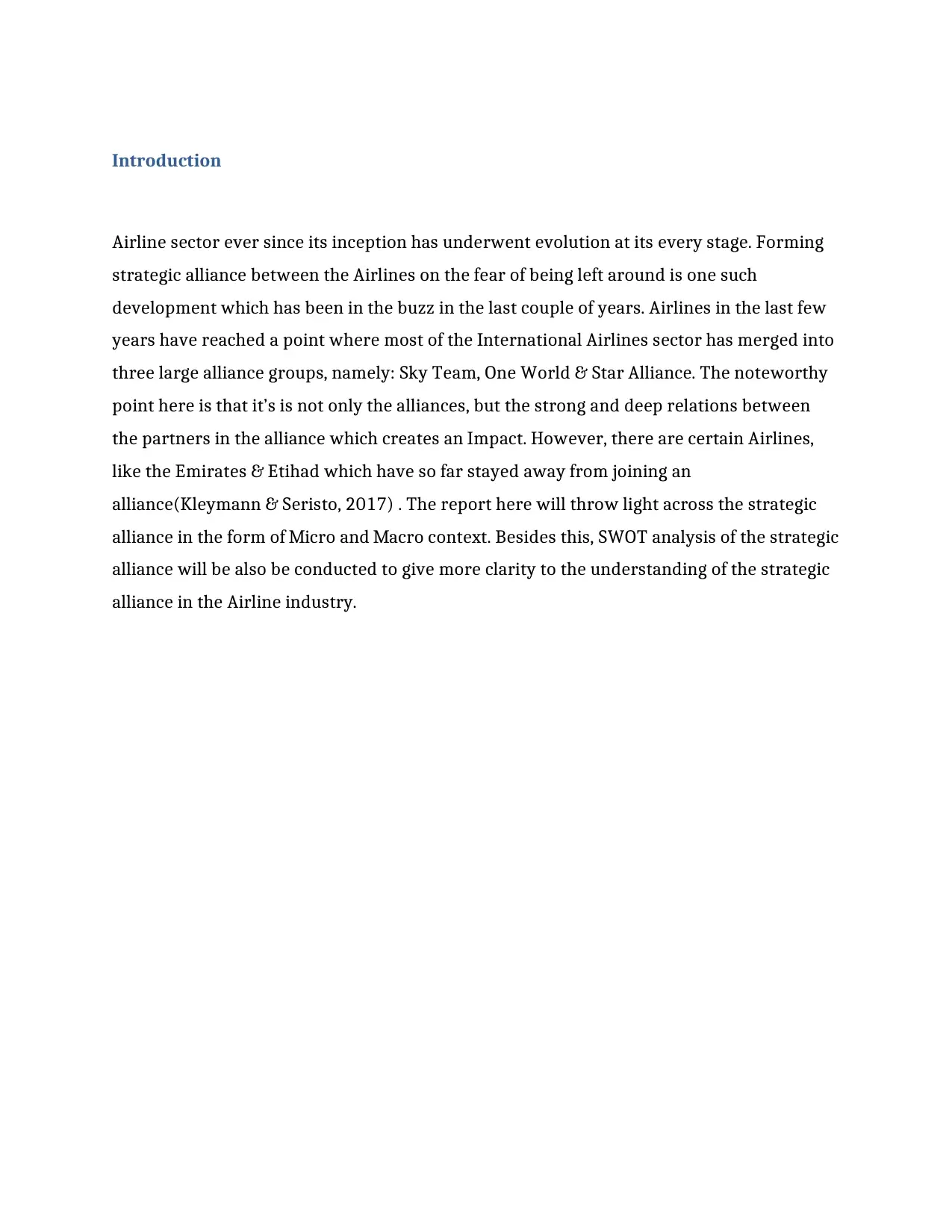
Introduction
Airline sector ever since its inception has underwent evolution at its every stage. Forming
strategic alliance between the Airlines on the fear of being left around is one such
development which has been in the buzz in the last couple of years. Airlines in the last few
years have reached a point where most of the International Airlines sector has merged into
three large alliance groups, namely: Sky Team, One World & Star Alliance. The noteworthy
point here is that it’s is not only the alliances, but the strong and deep relations between
the partners in the alliance which creates an Impact. However, there are certain Airlines,
like the Emirates & Etihad which have so far stayed away from joining an
alliance(Kleymann & Seristo, 2017) . The report here will throw light across the strategic
alliance in the form of Micro and Macro context. Besides this, SWOT analysis of the strategic
alliance will be also be conducted to give more clarity to the understanding of the strategic
alliance in the Airline industry.
Airline sector ever since its inception has underwent evolution at its every stage. Forming
strategic alliance between the Airlines on the fear of being left around is one such
development which has been in the buzz in the last couple of years. Airlines in the last few
years have reached a point where most of the International Airlines sector has merged into
three large alliance groups, namely: Sky Team, One World & Star Alliance. The noteworthy
point here is that it’s is not only the alliances, but the strong and deep relations between
the partners in the alliance which creates an Impact. However, there are certain Airlines,
like the Emirates & Etihad which have so far stayed away from joining an
alliance(Kleymann & Seristo, 2017) . The report here will throw light across the strategic
alliance in the form of Micro and Macro context. Besides this, SWOT analysis of the strategic
alliance will be also be conducted to give more clarity to the understanding of the strategic
alliance in the Airline industry.
⊘ This is a preview!⊘
Do you want full access?
Subscribe today to unlock all pages.

Trusted by 1+ million students worldwide
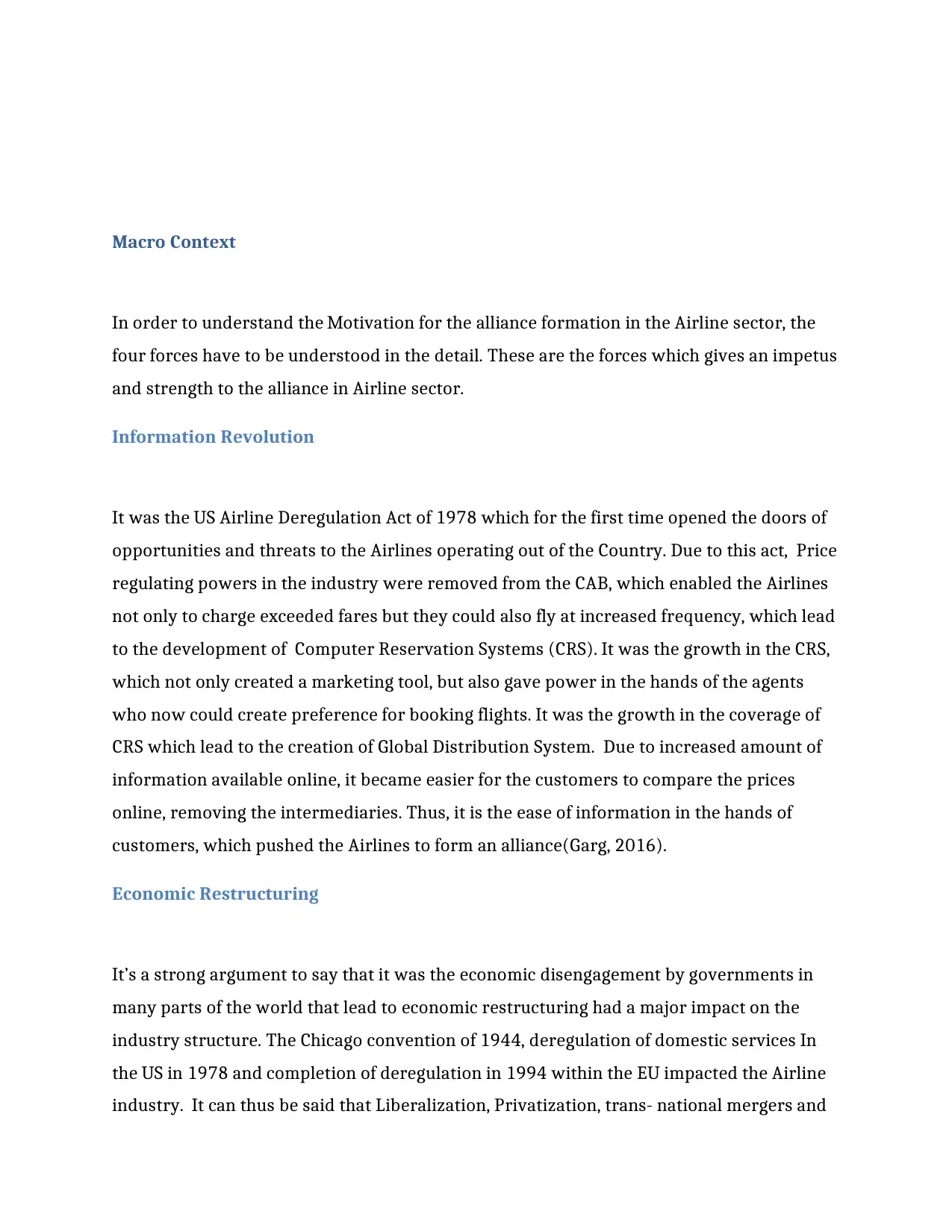
Macro Context
In order to understand the Motivation for the alliance formation in the Airline sector, the
four forces have to be understood in the detail. These are the forces which gives an impetus
and strength to the alliance in Airline sector.
Information Revolution
It was the US Airline Deregulation Act of 1978 which for the first time opened the doors of
opportunities and threats to the Airlines operating out of the Country. Due to this act, Price
regulating powers in the industry were removed from the CAB, which enabled the Airlines
not only to charge exceeded fares but they could also fly at increased frequency, which lead
to the development of Computer Reservation Systems (CRS). It was the growth in the CRS,
which not only created a marketing tool, but also gave power in the hands of the agents
who now could create preference for booking flights. It was the growth in the coverage of
CRS which lead to the creation of Global Distribution System. Due to increased amount of
information available online, it became easier for the customers to compare the prices
online, removing the intermediaries. Thus, it is the ease of information in the hands of
customers, which pushed the Airlines to form an alliance(Garg, 2016).
Economic Restructuring
It’s a strong argument to say that it was the economic disengagement by governments in
many parts of the world that lead to economic restructuring had a major impact on the
industry structure. The Chicago convention of 1944, deregulation of domestic services In
the US in 1978 and completion of deregulation in 1994 within the EU impacted the Airline
industry. It can thus be said that Liberalization, Privatization, trans- national mergers and
In order to understand the Motivation for the alliance formation in the Airline sector, the
four forces have to be understood in the detail. These are the forces which gives an impetus
and strength to the alliance in Airline sector.
Information Revolution
It was the US Airline Deregulation Act of 1978 which for the first time opened the doors of
opportunities and threats to the Airlines operating out of the Country. Due to this act, Price
regulating powers in the industry were removed from the CAB, which enabled the Airlines
not only to charge exceeded fares but they could also fly at increased frequency, which lead
to the development of Computer Reservation Systems (CRS). It was the growth in the CRS,
which not only created a marketing tool, but also gave power in the hands of the agents
who now could create preference for booking flights. It was the growth in the coverage of
CRS which lead to the creation of Global Distribution System. Due to increased amount of
information available online, it became easier for the customers to compare the prices
online, removing the intermediaries. Thus, it is the ease of information in the hands of
customers, which pushed the Airlines to form an alliance(Garg, 2016).
Economic Restructuring
It’s a strong argument to say that it was the economic disengagement by governments in
many parts of the world that lead to economic restructuring had a major impact on the
industry structure. The Chicago convention of 1944, deregulation of domestic services In
the US in 1978 and completion of deregulation in 1994 within the EU impacted the Airline
industry. It can thus be said that Liberalization, Privatization, trans- national mergers and
Paraphrase This Document
Need a fresh take? Get an instant paraphrase of this document with our AI Paraphraser
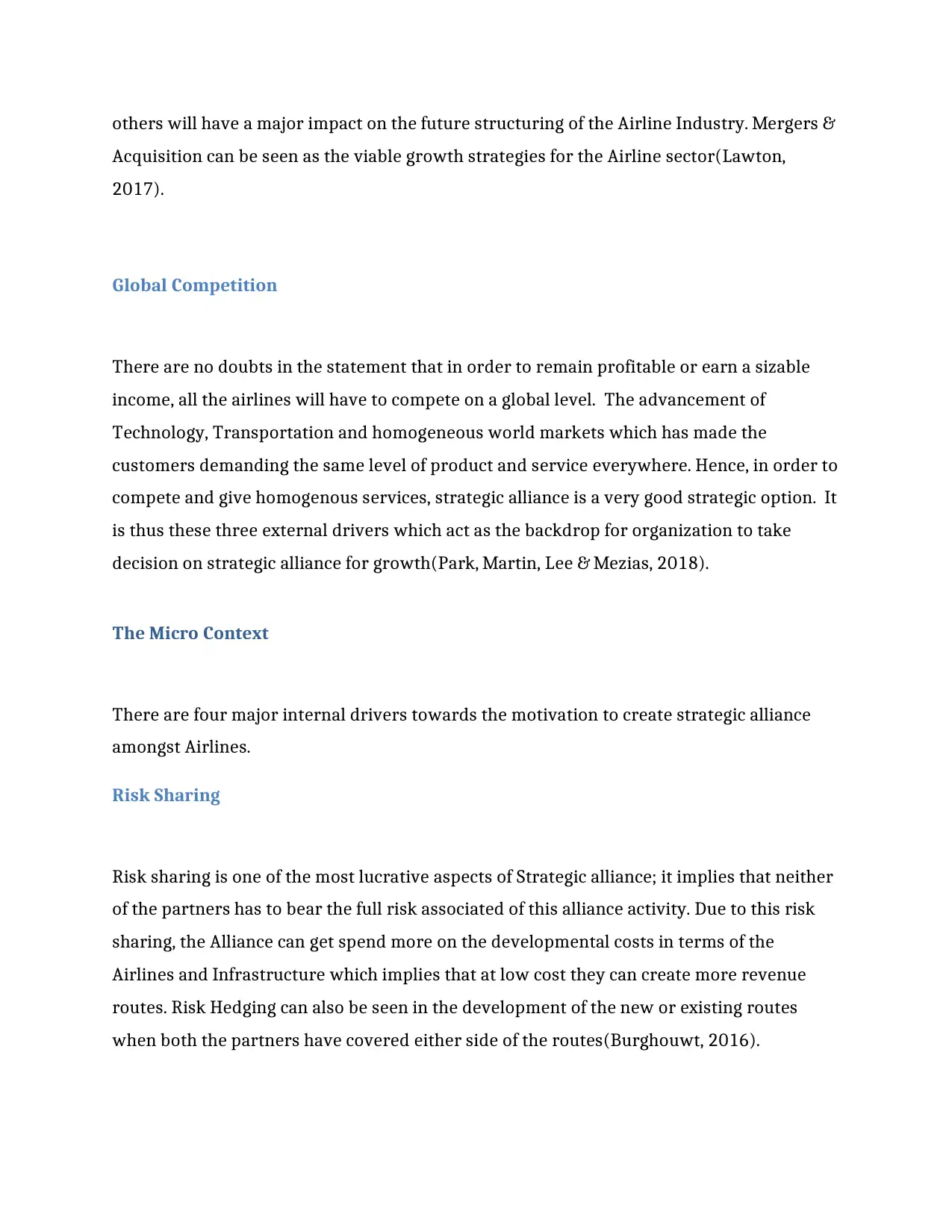
others will have a major impact on the future structuring of the Airline Industry. Mergers &
Acquisition can be seen as the viable growth strategies for the Airline sector(Lawton,
2017).
Global Competition
There are no doubts in the statement that in order to remain profitable or earn a sizable
income, all the airlines will have to compete on a global level. The advancement of
Technology, Transportation and homogeneous world markets which has made the
customers demanding the same level of product and service everywhere. Hence, in order to
compete and give homogenous services, strategic alliance is a very good strategic option. It
is thus these three external drivers which act as the backdrop for organization to take
decision on strategic alliance for growth(Park, Martin, Lee & Mezias, 2018).
The Micro Context
There are four major internal drivers towards the motivation to create strategic alliance
amongst Airlines.
Risk Sharing
Risk sharing is one of the most lucrative aspects of Strategic alliance; it implies that neither
of the partners has to bear the full risk associated of this alliance activity. Due to this risk
sharing, the Alliance can get spend more on the developmental costs in terms of the
Airlines and Infrastructure which implies that at low cost they can create more revenue
routes. Risk Hedging can also be seen in the development of the new or existing routes
when both the partners have covered either side of the routes(Burghouwt, 2016).
Acquisition can be seen as the viable growth strategies for the Airline sector(Lawton,
2017).
Global Competition
There are no doubts in the statement that in order to remain profitable or earn a sizable
income, all the airlines will have to compete on a global level. The advancement of
Technology, Transportation and homogeneous world markets which has made the
customers demanding the same level of product and service everywhere. Hence, in order to
compete and give homogenous services, strategic alliance is a very good strategic option. It
is thus these three external drivers which act as the backdrop for organization to take
decision on strategic alliance for growth(Park, Martin, Lee & Mezias, 2018).
The Micro Context
There are four major internal drivers towards the motivation to create strategic alliance
amongst Airlines.
Risk Sharing
Risk sharing is one of the most lucrative aspects of Strategic alliance; it implies that neither
of the partners has to bear the full risk associated of this alliance activity. Due to this risk
sharing, the Alliance can get spend more on the developmental costs in terms of the
Airlines and Infrastructure which implies that at low cost they can create more revenue
routes. Risk Hedging can also be seen in the development of the new or existing routes
when both the partners have covered either side of the routes(Burghouwt, 2016).
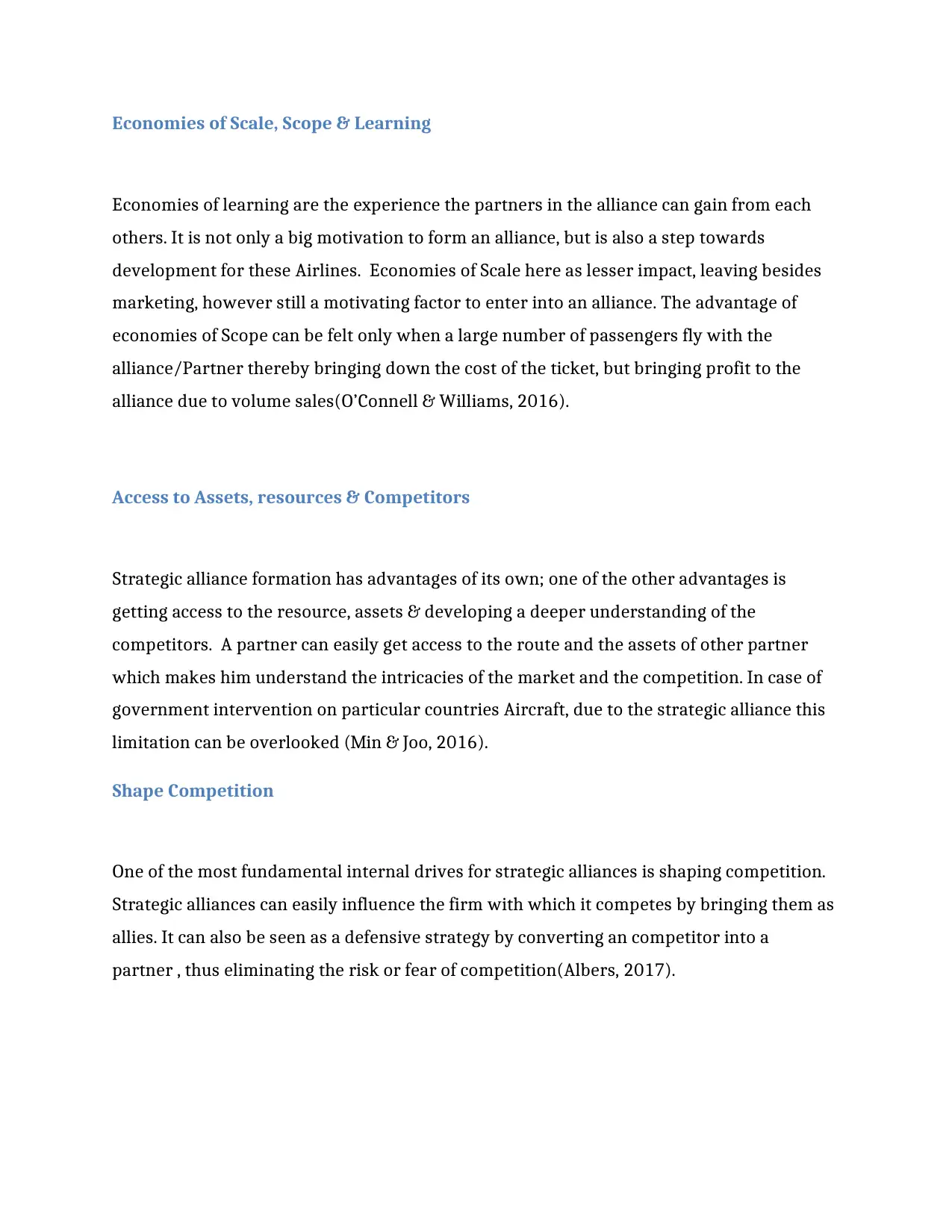
Economies of Scale, Scope & Learning
Economies of learning are the experience the partners in the alliance can gain from each
others. It is not only a big motivation to form an alliance, but is also a step towards
development for these Airlines. Economies of Scale here as lesser impact, leaving besides
marketing, however still a motivating factor to enter into an alliance. The advantage of
economies of Scope can be felt only when a large number of passengers fly with the
alliance/Partner thereby bringing down the cost of the ticket, but bringing profit to the
alliance due to volume sales(O’Connell & Williams, 2016).
Access to Assets, resources & Competitors
Strategic alliance formation has advantages of its own; one of the other advantages is
getting access to the resource, assets & developing a deeper understanding of the
competitors. A partner can easily get access to the route and the assets of other partner
which makes him understand the intricacies of the market and the competition. In case of
government intervention on particular countries Aircraft, due to the strategic alliance this
limitation can be overlooked (Min & Joo, 2016).
Shape Competition
One of the most fundamental internal drives for strategic alliances is shaping competition.
Strategic alliances can easily influence the firm with which it competes by bringing them as
allies. It can also be seen as a defensive strategy by converting an competitor into a
partner , thus eliminating the risk or fear of competition(Albers, 2017).
Economies of learning are the experience the partners in the alliance can gain from each
others. It is not only a big motivation to form an alliance, but is also a step towards
development for these Airlines. Economies of Scale here as lesser impact, leaving besides
marketing, however still a motivating factor to enter into an alliance. The advantage of
economies of Scope can be felt only when a large number of passengers fly with the
alliance/Partner thereby bringing down the cost of the ticket, but bringing profit to the
alliance due to volume sales(O’Connell & Williams, 2016).
Access to Assets, resources & Competitors
Strategic alliance formation has advantages of its own; one of the other advantages is
getting access to the resource, assets & developing a deeper understanding of the
competitors. A partner can easily get access to the route and the assets of other partner
which makes him understand the intricacies of the market and the competition. In case of
government intervention on particular countries Aircraft, due to the strategic alliance this
limitation can be overlooked (Min & Joo, 2016).
Shape Competition
One of the most fundamental internal drives for strategic alliances is shaping competition.
Strategic alliances can easily influence the firm with which it competes by bringing them as
allies. It can also be seen as a defensive strategy by converting an competitor into a
partner , thus eliminating the risk or fear of competition(Albers, 2017).
⊘ This is a preview!⊘
Do you want full access?
Subscribe today to unlock all pages.

Trusted by 1+ million students worldwide
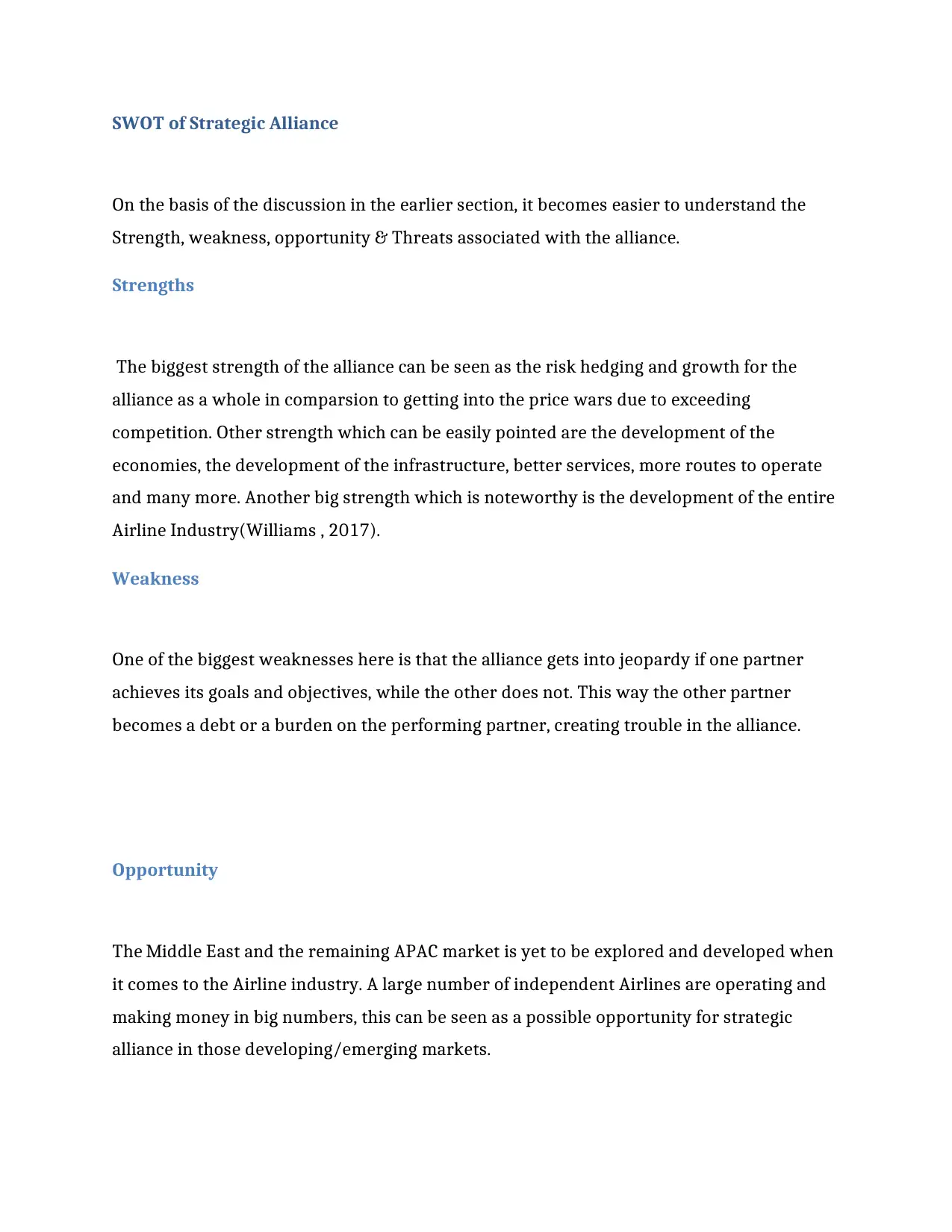
SWOT of Strategic Alliance
On the basis of the discussion in the earlier section, it becomes easier to understand the
Strength, weakness, opportunity & Threats associated with the alliance.
Strengths
The biggest strength of the alliance can be seen as the risk hedging and growth for the
alliance as a whole in comparsion to getting into the price wars due to exceeding
competition. Other strength which can be easily pointed are the development of the
economies, the development of the infrastructure, better services, more routes to operate
and many more. Another big strength which is noteworthy is the development of the entire
Airline Industry(Williams , 2017).
Weakness
One of the biggest weaknesses here is that the alliance gets into jeopardy if one partner
achieves its goals and objectives, while the other does not. This way the other partner
becomes a debt or a burden on the performing partner, creating trouble in the alliance.
Opportunity
The Middle East and the remaining APAC market is yet to be explored and developed when
it comes to the Airline industry. A large number of independent Airlines are operating and
making money in big numbers, this can be seen as a possible opportunity for strategic
alliance in those developing/emerging markets.
On the basis of the discussion in the earlier section, it becomes easier to understand the
Strength, weakness, opportunity & Threats associated with the alliance.
Strengths
The biggest strength of the alliance can be seen as the risk hedging and growth for the
alliance as a whole in comparsion to getting into the price wars due to exceeding
competition. Other strength which can be easily pointed are the development of the
economies, the development of the infrastructure, better services, more routes to operate
and many more. Another big strength which is noteworthy is the development of the entire
Airline Industry(Williams , 2017).
Weakness
One of the biggest weaknesses here is that the alliance gets into jeopardy if one partner
achieves its goals and objectives, while the other does not. This way the other partner
becomes a debt or a burden on the performing partner, creating trouble in the alliance.
Opportunity
The Middle East and the remaining APAC market is yet to be explored and developed when
it comes to the Airline industry. A large number of independent Airlines are operating and
making money in big numbers, this can be seen as a possible opportunity for strategic
alliance in those developing/emerging markets.
Paraphrase This Document
Need a fresh take? Get an instant paraphrase of this document with our AI Paraphraser
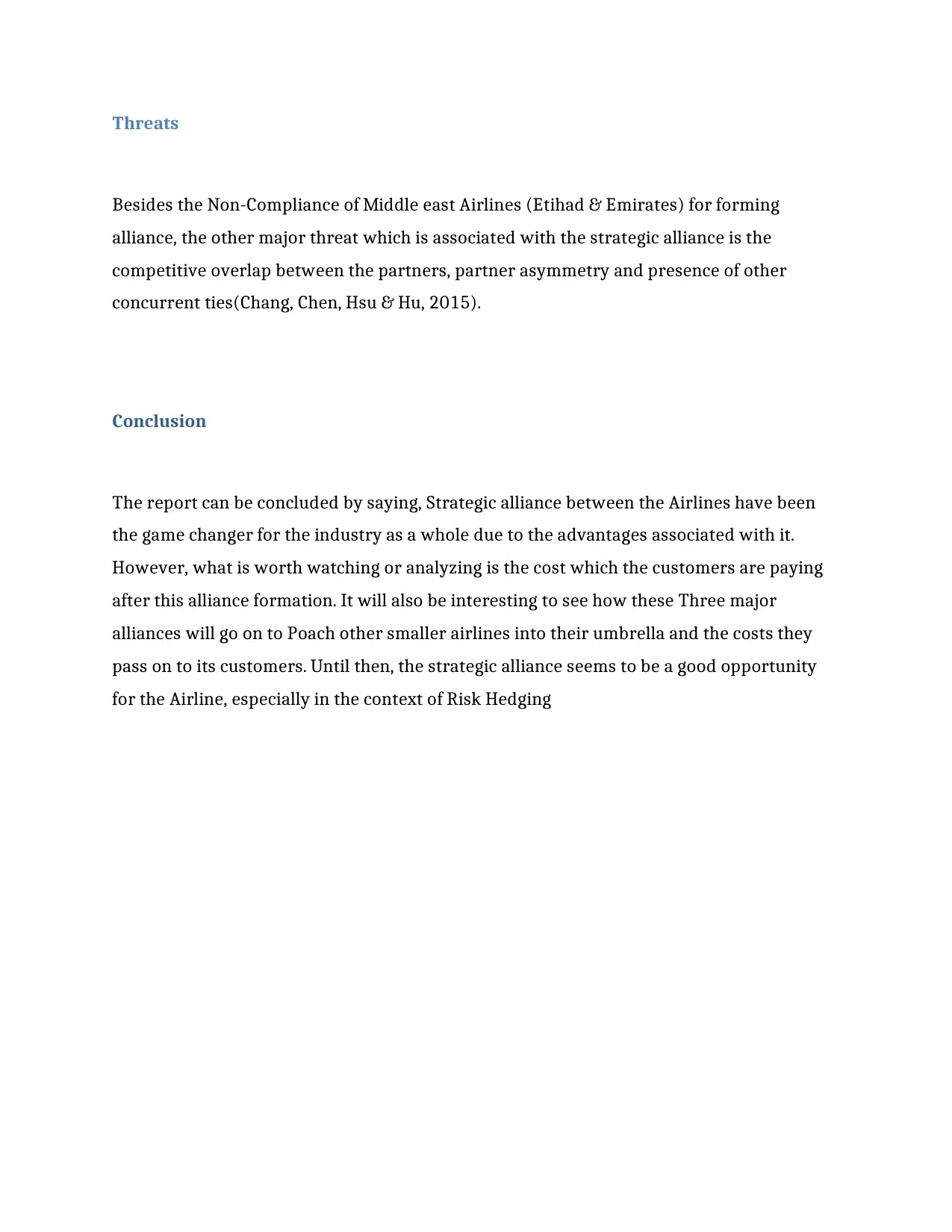
Threats
Besides the Non-Compliance of Middle east Airlines (Etihad & Emirates) for forming
alliance, the other major threat which is associated with the strategic alliance is the
competitive overlap between the partners, partner asymmetry and presence of other
concurrent ties(Chang, Chen, Hsu & Hu, 2015).
Conclusion
The report can be concluded by saying, Strategic alliance between the Airlines have been
the game changer for the industry as a whole due to the advantages associated with it.
However, what is worth watching or analyzing is the cost which the customers are paying
after this alliance formation. It will also be interesting to see how these Three major
alliances will go on to Poach other smaller airlines into their umbrella and the costs they
pass on to its customers. Until then, the strategic alliance seems to be a good opportunity
for the Airline, especially in the context of Risk Hedging
Besides the Non-Compliance of Middle east Airlines (Etihad & Emirates) for forming
alliance, the other major threat which is associated with the strategic alliance is the
competitive overlap between the partners, partner asymmetry and presence of other
concurrent ties(Chang, Chen, Hsu & Hu, 2015).
Conclusion
The report can be concluded by saying, Strategic alliance between the Airlines have been
the game changer for the industry as a whole due to the advantages associated with it.
However, what is worth watching or analyzing is the cost which the customers are paying
after this alliance formation. It will also be interesting to see how these Three major
alliances will go on to Poach other smaller airlines into their umbrella and the costs they
pass on to its customers. Until then, the strategic alliance seems to be a good opportunity
for the Airline, especially in the context of Risk Hedging
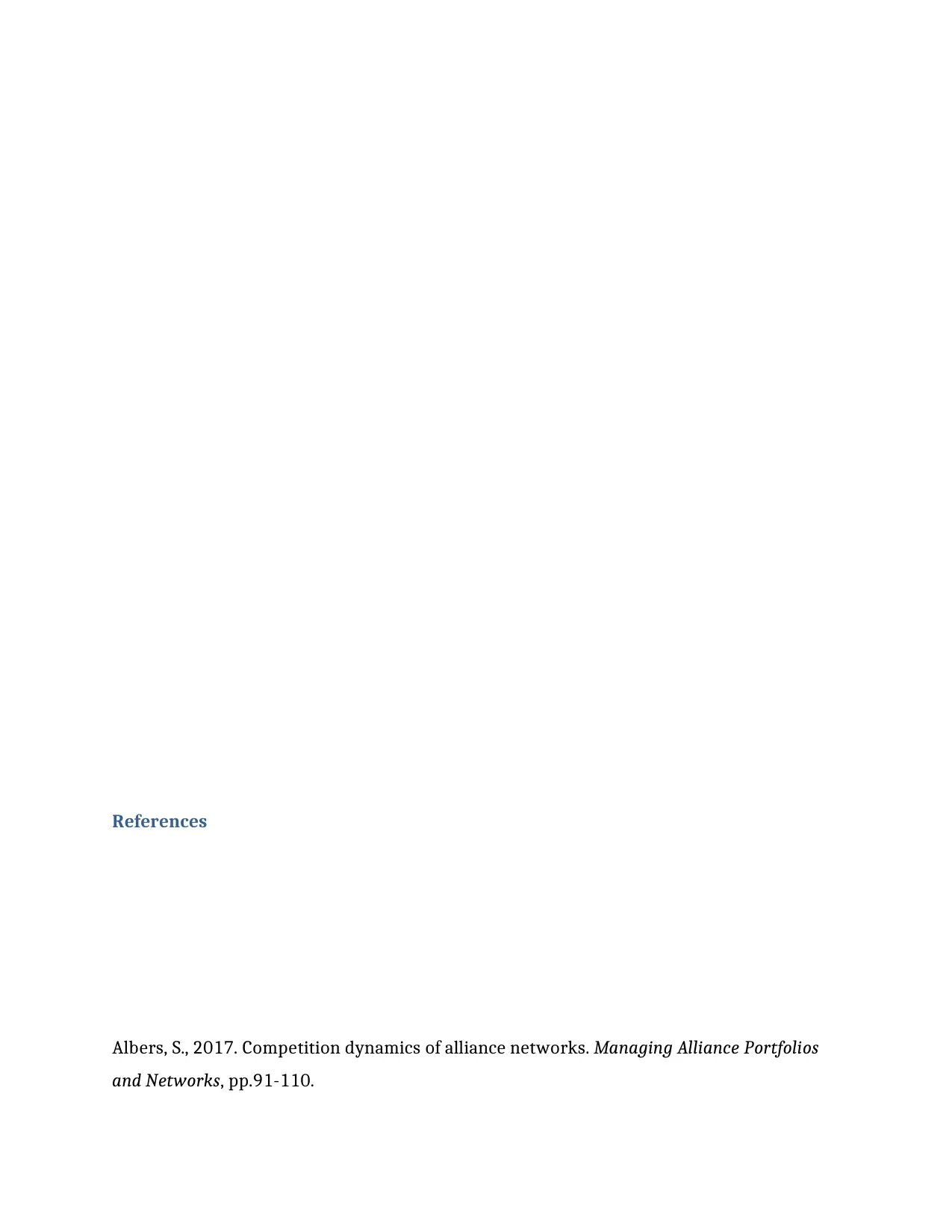
References
Albers, S., 2017. Competition dynamics of alliance networks. Managing Alliance Portfolios
and Networks, pp.91-110.
Albers, S., 2017. Competition dynamics of alliance networks. Managing Alliance Portfolios
and Networks, pp.91-110.
⊘ This is a preview!⊘
Do you want full access?
Subscribe today to unlock all pages.

Trusted by 1+ million students worldwide
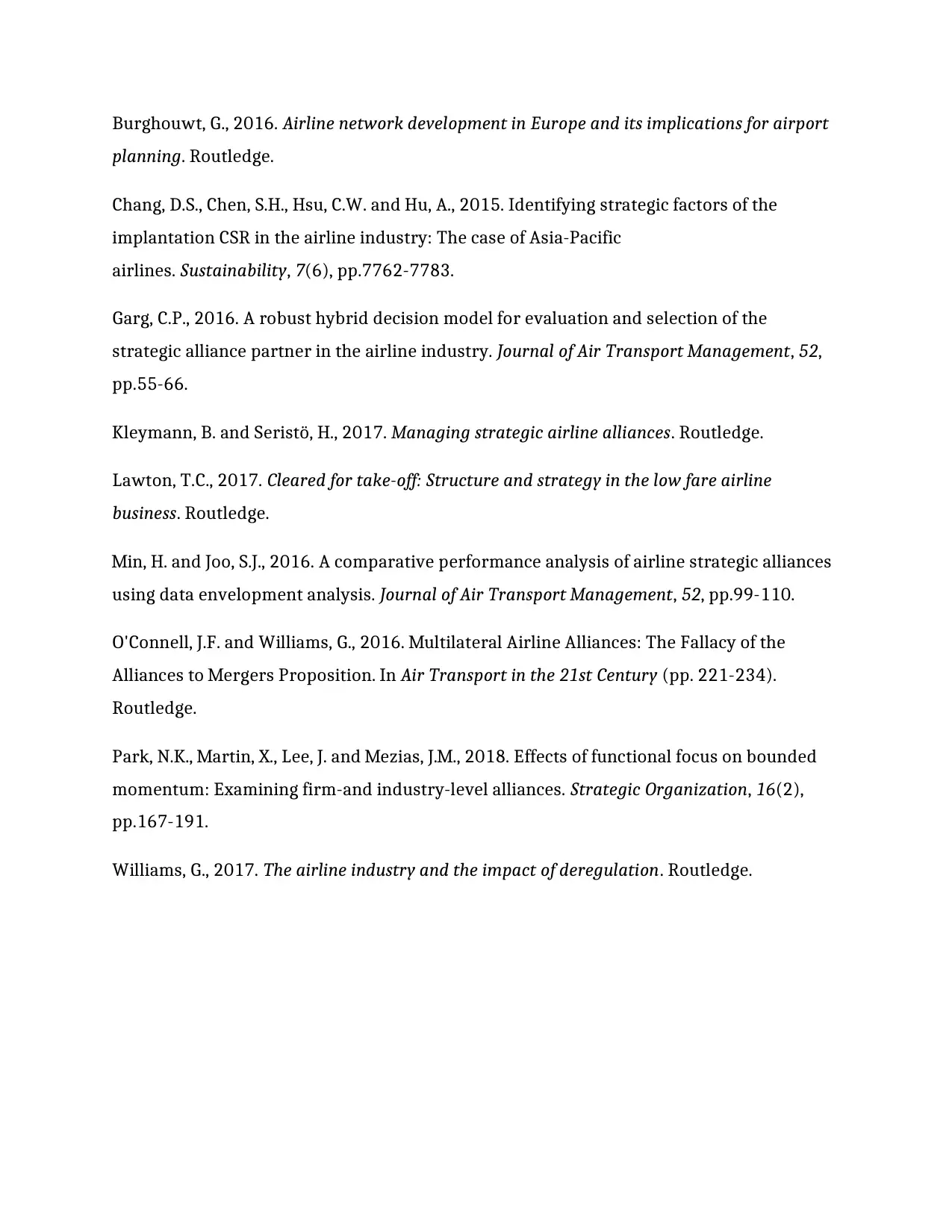
Burghouwt, G., 2016. Airline network development in Europe and its implications for airport
planning. Routledge.
Chang, D.S., Chen, S.H., Hsu, C.W. and Hu, A., 2015. Identifying strategic factors of the
implantation CSR in the airline industry: The case of Asia-Pacific
airlines. Sustainability, 7(6), pp.7762-7783.
Garg, C.P., 2016. A robust hybrid decision model for evaluation and selection of the
strategic alliance partner in the airline industry. Journal of Air Transport Management, 52,
pp.55-66.
Kleymann, B. and Seristö, H., 2017. Managing strategic airline alliances. Routledge.
Lawton, T.C., 2017. Cleared for take-off: Structure and strategy in the low fare airline
business. Routledge.
Min, H. and Joo, S.J., 2016. A comparative performance analysis of airline strategic alliances
using data envelopment analysis. Journal of Air Transport Management, 52, pp.99-110.
O'Connell, J.F. and Williams, G., 2016. Multilateral Airline Alliances: The Fallacy of the
Alliances to Mergers Proposition. In Air Transport in the 21st Century (pp. 221-234).
Routledge.
Park, N.K., Martin, X., Lee, J. and Mezias, J.M., 2018. Effects of functional focus on bounded
momentum: Examining firm-and industry-level alliances. Strategic Organization, 16(2),
pp.167-191.
Williams, G., 2017. The airline industry and the impact of deregulation. Routledge.
planning. Routledge.
Chang, D.S., Chen, S.H., Hsu, C.W. and Hu, A., 2015. Identifying strategic factors of the
implantation CSR in the airline industry: The case of Asia-Pacific
airlines. Sustainability, 7(6), pp.7762-7783.
Garg, C.P., 2016. A robust hybrid decision model for evaluation and selection of the
strategic alliance partner in the airline industry. Journal of Air Transport Management, 52,
pp.55-66.
Kleymann, B. and Seristö, H., 2017. Managing strategic airline alliances. Routledge.
Lawton, T.C., 2017. Cleared for take-off: Structure and strategy in the low fare airline
business. Routledge.
Min, H. and Joo, S.J., 2016. A comparative performance analysis of airline strategic alliances
using data envelopment analysis. Journal of Air Transport Management, 52, pp.99-110.
O'Connell, J.F. and Williams, G., 2016. Multilateral Airline Alliances: The Fallacy of the
Alliances to Mergers Proposition. In Air Transport in the 21st Century (pp. 221-234).
Routledge.
Park, N.K., Martin, X., Lee, J. and Mezias, J.M., 2018. Effects of functional focus on bounded
momentum: Examining firm-and industry-level alliances. Strategic Organization, 16(2),
pp.167-191.
Williams, G., 2017. The airline industry and the impact of deregulation. Routledge.
Paraphrase This Document
Need a fresh take? Get an instant paraphrase of this document with our AI Paraphraser

1 out of 11
Related Documents
Your All-in-One AI-Powered Toolkit for Academic Success.
+13062052269
info@desklib.com
Available 24*7 on WhatsApp / Email
![[object Object]](/_next/static/media/star-bottom.7253800d.svg)
Unlock your academic potential
Copyright © 2020–2025 A2Z Services. All Rights Reserved. Developed and managed by ZUCOL.





